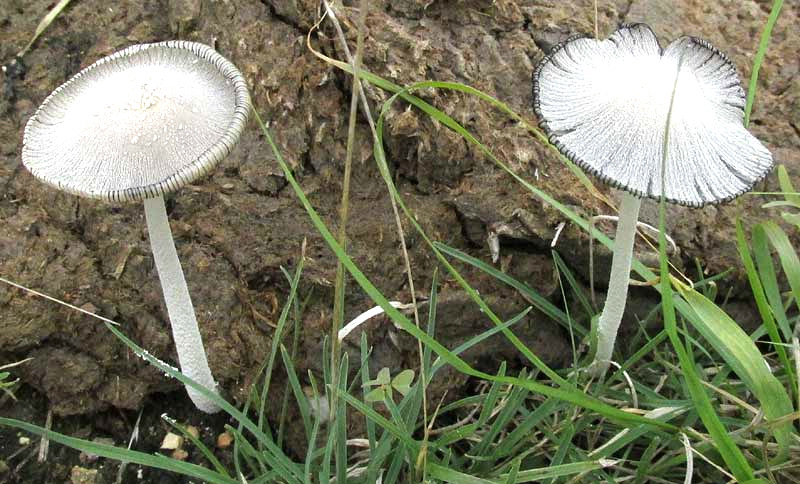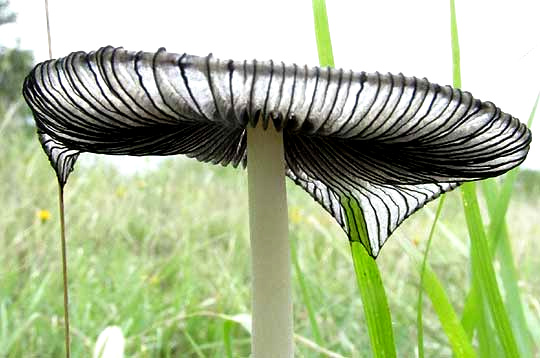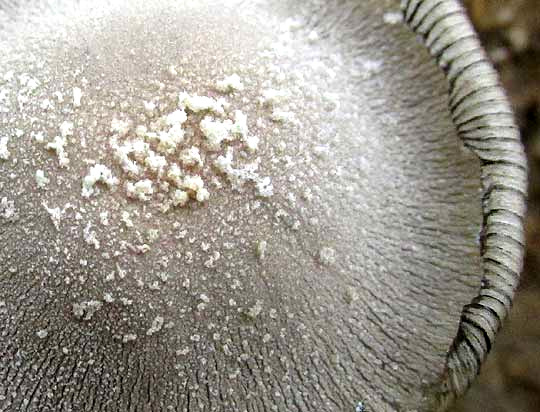Excerpts from Jim Conrad's
Naturalist Newsletter

from the September 21, 2014 Newsletter issued from the Frio Canyon Nature Education Center in the valley of the Dry Frio River in northern Uvalde County, southwestern Texas, on the southern border of the Edwards Plateau; elevation ~1750m (~5750 ft); N29.62°, W99.86°; USA
SNOWY INKCAP MUSHROOM
Several days ago we received a rare rain, and after months of no mushrooms at all, finally a few are appearing. For example, issuing from a dried-out pile of cow manure beside the road were the delicate, inch-tall ones (2.5cm) shown above.
Mushroom fanciers recognize these as members of that group of tiny, ephemeral mushrooms that appear overnight, then literally melt as the next day advances. Even these were about to liquefy, or "autodigest," as shown below by the drooping rims seen in a side view:

Inky caps as a group are easy to recognize, but finding out one's species name can be very hard. However, these cow-pad ones displayed a special feature on the cap, nicely shown below:

What's special is not the cap's neatly curled-up rims, for this is typical of many inky cap species, whose caps start out shaped like narrow thimbles pointing skyward, then as they mature flatten out, and finally curl upward, liquefying. What's special is the mealy-white particles scattered across the cap's center. That meal consists of "velar remains," or traces of the mushroom's velum or "veil." Veils, more precisely known as "universal veils," are temporary membranous tissues completely enshrouding immature, egg-like fruiting bodies of certain kinds of gilled mushrooms. The egg-like thing forms in the ground or organic litter, then the fruiting body we think of as the mushroom "hatches" from the "egg," breaking the "egg's" veil, and sometimes particles of the shattered veil stick to the mushroom's cap. That's happened here.
Referring to inky cap mushrooms in general, Michael Kuo, the expert at MushroomExpert.Com, writes that "Identification of these short-lived mushrooms (did I mention that they all look pretty much the same?) hinges on microscopic examination of various erudite features, and is an enterprise best left to folks who enjoy such endeavors."
He also points out that recent DNA studies reveal that the big group of mushrooms traditionally known as inky caps is composed of many species often not very closely related to one another. It's a matter of convergent evolution. That is, being a small, fragile mushroom with cap edges that curl up as the cap liquefies and spores are released into the wind -- is a very successful strategy. Therefore, various unrelated mushroom groups have evolved to employ the strategy, in the process coming to look and behave pretty much like other species taking up the same strategy.
It's the same convergent-evolution situation as with vultures. American vultures and European vultures are similar looking and with similar behaviors, yet American vultures have evolved from stork-like birds while European vultures are closer related to hawks and falcons. It's just that the carrion-eating niche is best exploited by birds looking and behaving the way vultures do, no matter who their ancestors were.
Anyway, taking into account the above caveats about even trying to identify inky cap mushrooms to species level, I'm placing this entry under the name of the Snowy Inkcap, COPRINOPSIS NIVEA, because that's a common species found in our area, it grows on dung, and its cap is flecked with white "velar remains" exactly like this. Even if our mushrooms happen to be a different species, it's of value to experts to see what we have here in southwestern Texas.
This is such a small, delicate mushroom that it's not worth eating. It's been variously reported as toxic or at least "suspect," so it's not a good idea to nibble on it.